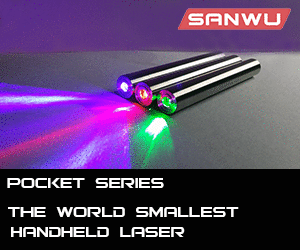I found this on a Thorlabs.
This is 1208nm 3W laser diode, it has a reasonable price.
Link:
https://www.thorlabs.de/thorproduct.cfm?partnumber=BAL1112CM
Is it possible to frequency double 1208nm? Would give decent orange beam if possible.
What do you think?
Searching forums didn’t gave any success about this topic.
Sorry if double thread.
Apparently you did not search the LPF data base--there is a discussion of the same thing see post #4 of May 2011. which also comes up if you search LPF orgoogle so....see here:
https://laserpointerforums.com/f40/why-can-t-we-frequency-double-1208nm-63234.html
"As I've said before about KTP and 'throwing photons KTP with a diode for them to shit out a stream of photons out the other end', it isn't a very straightforward process. Finding the correct wavelength is only the start of it.
First off, due to a property inherent to KTP, it cannot double well below 500nm, and not all in the blue, as it cannot be phase-matched for those wavelengths. This same property allows it to double 1064nm with such brutal efficiency.
KTP is also used in the SHG of 1319 and 1342 for 660 and 671nm respectively (both are Nd:YAG/YVO4 lines). It's also used in SFG (sum frequency generation) for both 589 and 594.5nm.
The second issue that comes to mind is power density- and although it may seem easy to get plenty of power (5W in a C-mount 808 is easy to get), cramming that power into something that is usable is not nearly as easy.
First off, although 3W (like in the diode you linked) may seem like a lot of power, bear a few things in mind:
1. Being a multimode, multi-emitter device, the output beam will be very messy, not to mention extremely astigmatic.
2. There'll be no easy way to focus that down to the spot size needed for effective SHG.
To put things into perspective, your dinky little 5mW green pen laser has watts of power circulating through the cavity at any given time. Only a small percentage ever makes it out as 532nm, of course, and most of that power remains in the cavity.
The other thing about said dinky pen laser is that the intracavity 1064nm beam is often micrometers wide. Without a FAC, the intracavity beam is usually slightly smaller than diode's active emitting area, while with a FAC, the intracavity 1064 is often narrower.
So, you have many watts of power in a tiny spot. SHG, being a non-linear process, works better almost exponentially as power levels rise.
Put those two together, and you'll see that sending a single diode for a pass through a doubling crystal won't work.
Case-in-point: An SSY-1 (flashlamp-pumped pulsed Nd:YAG laser with a nominal peak power of 200mJ) has trouble achieving green output when it is shot through a KTP crystal. The same laser with a passive Q-switch (which serves to increase the peak power) has no problem with extracavity doubling. Without the Q-switch, the power is on the order of kW, while with the Q-switch, it rises to hundreds of kW (or even into the MW range if pumped correctly).
Of course, with the diode being multimode and multi-emitter, getting it to the point size necessary is extremely difficult. And even if you do manage to break a handful of the laws of physics and pull it off, it'll be an even bigger challenge to contain it within the doubling crystal.
On top of that, the diode has to be phase-matched with the doubler crystal. Due to the beam profile and astigmatism involved often this can't be done with a diode.
When you have seen a directly-doubled diode (such as the Novalux Protera 488 series), they use a special external-cavity VESCEL diode. The VESCEL diode design eliminates the astigmatism and poor beam profile inherent to normal diodes, while the external-cavity design means that the doubling optic is also part of the cavity, giving the power densities needed. Phase-matching can then be achieved, and a TEC is used to stabilise the doubling crystal and the diode to ensure temperature fluctuations do not result in an un-phase-matching of the setup."



